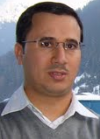SICOT e-Newsletter
Issue No. 57 - June 2013
Training Around the World

 Orthopaedic Training In Saudi Arabia
Orthopaedic Training In Saudi ArabiaMohammed Alshehri
National Guard Hospital, Jeddah, Saudi Arabia
The orthopaedic training in Saudi Arabia is a long and mostly exciting trip. It has some similarities to the orthopaedic training system in North America.
Undergraduate medical training in Saudi Arabia consists of six years in medical school. After this, each medical student needs to spend one year of internship rotating between the four major specialties. During the year of rotating internship, everyone has to pass the entrance exam for training programmes for medical specialties, which is considered as a medical license exam. Once the internship has been successfully completed, the candidate can apply for a residency position in his/her specialty of interest service.
The orthopaedic training programme is a unified programme at the State level and supervised by the Saudi commission for health specialties. It is a joint training between the approved medical centres in each region managed by a local committee.
There are three prerequisites to be eligible for orthopaedic training. The first one is obtaining approval from the workplace to join the training programme in orthopaedic surgery. This is followed by submission of application letter to the Saudi commission for health specialties. Finally, the candidate needs to pass the selection exam. This exam is unified all over the Saudi kingdom and also includes an interview organised by the local committee. Having successfully gone through all the prerequisites, the applicant can start his journey in orthopaedic training, which lasts for five years.
The first year is a mix between orthopaedic and non-orthopaedic specialties. Every trainee has to spend a period of three months in each of the intensive care, general surgery, plastic surgery and orthopaedic surgery units. The aim of training in the first year is to provide residents with basic surgical skills and expose them to surgical subspecialties that an orthopaedic surgeon needs to be familiar with.
The second and third years form multiple "3-month junior residency rotations" in various orthopaedic subspecialties at an approved training centre. The residents act at first on call during these years. They develop confidence in managing diverse emergency situations and are provided with hands-on supervised training in most of the orthopaedic trauma procedures.
In the fourth and fifth years of training, the trainee is addressed as a "senior resident". Aims of senior residency are to expose residents to all the diverse fields of orthopaedic surgery and allow them to participate in major elective orthopaedic procedures.
Annual promotion depends on yearly performance as assessed by the preceptors. In addition, each trainee needs to pass both clinical and written promotion exams that are conducted yearly. Promotion from third year to fourth year involves passing part 1 of the Board examination. Of late, the fourth year of residency training has increasingly involved research commitments in a field of interest of the residents. Advanced Trauma Life Support certification is mandatory for all trainees and this has to be taken once during the five years of training.
In all approved training centres, the trainee has to attend the daily morning meetings. There are fixed academic half days every week for all trainees in each city. These are highly organised with a fixed schedule of lectures, case presentations, and journal club presentations. Individual centres also run their own academic activity each week.
The Saudi orthopaedic training provides excellent hands-on training in trauma. Exposure to other subspecialties is variable and highly depends on the centre and the interests of the preceptors at that centre.
At the end of the fifth year eligible candidates sit for board examinations, which are held at least once per year in one training centre for trainees all over the country. The final examination consists of two parts: the written part and clinical/oral part. Candidates who pass the final examination are granted Saudi Board Certificate in orthopaedic surgery. Most graduate orthopaedic surgeons apply for subspecialty fellowships outside the Kingdom in Europe or North America.
The biggest strength of orthopaedic training in Saudi Arabia is its organisation as a joint programme between approved medical centres in a region. This ensures reasonable exposure of the trainees to different surgeons and various subspecialties. The biggest weakness of the programme is lack of standardisation in the residency programme and higher stress on "service" rather than "education". Surgical hands-on training is highly limited in elective surgeries and teaching of surgical skills to residents is not taken as a responsibility by many consultant surgeons.
Orthopaedic training in Saudi Arabia is evolving and there continues to be a lot of scope for improvement. We need to promote academic leaders who are willing not only to do research, but also highly dedicated to resident training. The newer generation of orthopaedic surgeons is increasingly trained in western countries, and has brought the latest innovations and technology to the field of orthopaedics in the Saudi Kingdom. The need of the hour is for some basic educational reforms, which will make sure that the training is comparable to the western world, with an eventual aim of building a better system for health and academic services in the Kingdom.
 Â
Undergraduate medical training in Saudi Arabia consists of six years in medical school. After this, each medical student needs to spend one year of internship rotating between the four major specialties. During the year of rotating internship, everyone has to pass the entrance exam for training programmes for medical specialties, which is considered as a medical license exam. Once the internship has been successfully completed, the candidate can apply for a residency position in his/her specialty of interest service.
The orthopaedic training programme is a unified programme at the State level and supervised by the Saudi commission for health specialties. It is a joint training between the approved medical centres in each region managed by a local committee.
There are three prerequisites to be eligible for orthopaedic training. The first one is obtaining approval from the workplace to join the training programme in orthopaedic surgery. This is followed by submission of application letter to the Saudi commission for health specialties. Finally, the candidate needs to pass the selection exam. This exam is unified all over the Saudi kingdom and also includes an interview organised by the local committee. Having successfully gone through all the prerequisites, the applicant can start his journey in orthopaedic training, which lasts for five years.
The first year is a mix between orthopaedic and non-orthopaedic specialties. Every trainee has to spend a period of three months in each of the intensive care, general surgery, plastic surgery and orthopaedic surgery units. The aim of training in the first year is to provide residents with basic surgical skills and expose them to surgical subspecialties that an orthopaedic surgeon needs to be familiar with.
The second and third years form multiple "3-month junior residency rotations" in various orthopaedic subspecialties at an approved training centre. The residents act at first on call during these years. They develop confidence in managing diverse emergency situations and are provided with hands-on supervised training in most of the orthopaedic trauma procedures.
In the fourth and fifth years of training, the trainee is addressed as a "senior resident". Aims of senior residency are to expose residents to all the diverse fields of orthopaedic surgery and allow them to participate in major elective orthopaedic procedures.
Annual promotion depends on yearly performance as assessed by the preceptors. In addition, each trainee needs to pass both clinical and written promotion exams that are conducted yearly. Promotion from third year to fourth year involves passing part 1 of the Board examination. Of late, the fourth year of residency training has increasingly involved research commitments in a field of interest of the residents. Advanced Trauma Life Support certification is mandatory for all trainees and this has to be taken once during the five years of training.
In all approved training centres, the trainee has to attend the daily morning meetings. There are fixed academic half days every week for all trainees in each city. These are highly organised with a fixed schedule of lectures, case presentations, and journal club presentations. Individual centres also run their own academic activity each week.
The Saudi orthopaedic training provides excellent hands-on training in trauma. Exposure to other subspecialties is variable and highly depends on the centre and the interests of the preceptors at that centre.
At the end of the fifth year eligible candidates sit for board examinations, which are held at least once per year in one training centre for trainees all over the country. The final examination consists of two parts: the written part and clinical/oral part. Candidates who pass the final examination are granted Saudi Board Certificate in orthopaedic surgery. Most graduate orthopaedic surgeons apply for subspecialty fellowships outside the Kingdom in Europe or North America.
The biggest strength of orthopaedic training in Saudi Arabia is its organisation as a joint programme between approved medical centres in a region. This ensures reasonable exposure of the trainees to different surgeons and various subspecialties. The biggest weakness of the programme is lack of standardisation in the residency programme and higher stress on "service" rather than "education". Surgical hands-on training is highly limited in elective surgeries and teaching of surgical skills to residents is not taken as a responsibility by many consultant surgeons.
Orthopaedic training in Saudi Arabia is evolving and there continues to be a lot of scope for improvement. We need to promote academic leaders who are willing not only to do research, but also highly dedicated to resident training. The newer generation of orthopaedic surgeons is increasingly trained in western countries, and has brought the latest innovations and technology to the field of orthopaedics in the Saudi Kingdom. The need of the hour is for some basic educational reforms, which will make sure that the training is comparable to the western world, with an eventual aim of building a better system for health and academic services in the Kingdom.
 Â